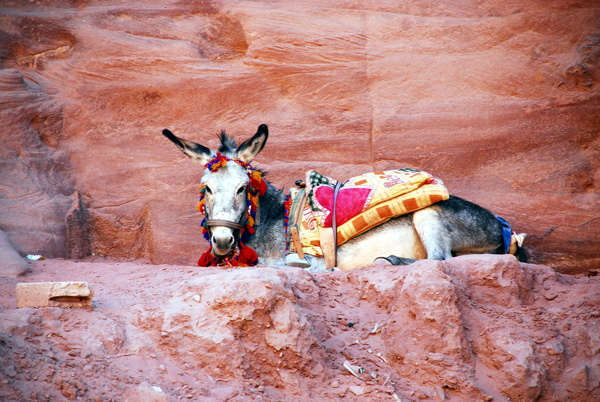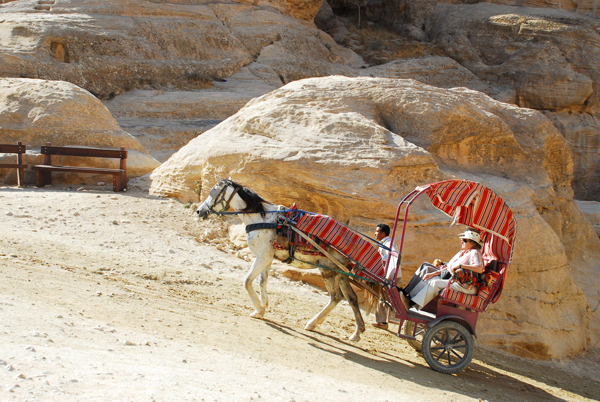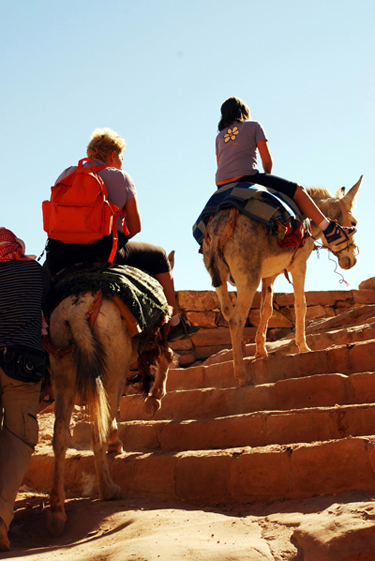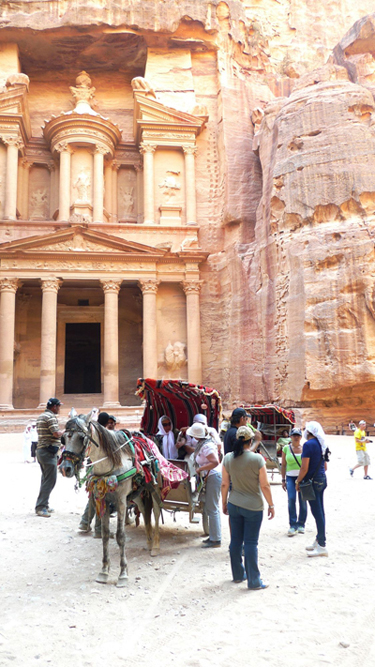Responsible Equestrian Tourism- the “Happy Horses Holiday Code”
Get educated on how you can be a responsible equestrian tourist and help improve the lives of working equines around the world.
by Jocelyn Pierce
Responsible tourism is a growing trend in the travel industry. The main objective of responsible tourism is to maximize economic, social, cultural, and environmental benefits in order to positively impact communities and promote a more meaningful connection between the tourist and the local. Millions of working equines are employed in the tourism industry in popular destinations around the world but are often overlooked. In developing countries especially, tourists contribute to, sometimes unknowingly, the suffering of working horses, donkeys, and mules. By understanding the factors that contribute to welfare issues and learning to recognize the signs of a suffering animal, tourists can make decisions that wholeheartedly embrace the dogma of responsible tourism.
Tourism is a major source of income for many countries. Consumers that realize the importance of sustainability and understand the impact of tourism are beginning to book conscientious vacations more frequently. Being a responsible traveler means having mindfulness and holding oneself accountable for the choices made which impact others. Animals are no exception, and they depend on humans to care for them.

The Brooke was established in 1934 by Dorothy Brooke and is now the leading welfare charity for working equine animals in the developing world. Photo credit The Brooke.
Working Equines in Tourism
Working horses, donkeys, and mules in the tourism industry help their owners earn a living and support their families. Depending on the destination, the well being of working equines differs greatly. The jobs they perform, hours they work, terrain they must cover, and resources available to them are all variables. Most commonly, equines in the tourism industry will pull carriages on sightseeing tours, carry tourists to monuments or other sites, will be raced or featured in ceremonies to attract tourists, or will be the sole means of transportation for multi-day treks.
In many developing countries, owners will cause greater stress to an animal in an attempt to make more money from the tourist. The horse, donkey, or mule will be asked to carry a heavier load, move at a faster rate, or take other shortcuts that negatively affect its welfare.
These horses, donkeys, and mules commonly suffer from lameness, dehydration, malnutrition, sores and wounds, disease, fear, and exhaustion. The working equines generally face a lack of shelter in harsh environments. They have difficult journeys, working up steep hills, stairs, rocky terrain, and hard ground. They are often worked too young, before their joints and bones are developmentally able to perform. They are also subject to high-risk traffic accidents in urban areas where carriages have to share the road with other vehicles.
The Brooke Hospital for Animals, along with other welfare charities, have been working to improve the lives of working equines in the tourism industry so that visitors can enjoy their vacation and positively impact the local economy without contributing to animal suffering. The Brooke works in ten countries around the world, and in many popular tourist destinations.

The Brooke works in 11 nations to help educate equine owners and to improve the welfare of working horses, donkeys and mules. Photo credit The Brooke.
Happy Horses Holiday Code
Kimberly Wells, the Senior Welfare Advisor at the Brooke has developed the "Happy Horses Holiday Code," general guidelines to raise awareness and educate tourists on the importance of equine welfare. Wells “firmly believes that by promoting good animal welfare and working practices, we can decrease instances of animal suffering and improve the day to day lives of these animals.”
The Brooke receives complaints from concerned tourists about the welfare of equines, even in countries where they do not operate. Due to their limited resources, the Brooke cannot possibly help all the equines in need, so must rely on tourists to have a responsible approach.
The ten point “Happy Horses Holiday Code” highlights the issues the Brooke has witnessed and gives advice on how to prevent them. The code encourages tourists to ask, “Is the animal happy and healthy? Can it carry or pull my weight? Am I paying a fair price?” Tourists can use the code as a guide to help them make an educated decision on choosing an animal.
The Brooke asks when selecting a horse or donkey, to look closely at the animal. He should have an overall appearance of good health. You should not be able to see prominent ribs, hips, backbones, or pelvis. He should have an alert expression, ears forward, clear eyes, and should be standing evenly. Shoddy or dirty equipment can rub the mouth, shoulders, spine, or stomach, so look for sores and wounds in areas that the tack covers.
Heavy loads can cause many stresses and injuries on an equines’ body, including bone fractures. The code encourages tourists to be aware of their size in relation to the animal and pick an appropriate mount. No horse, donkey, or mule should ever carry more than one rider at a time. The animal should walk easily with no sign of lameness.
If you are on a horse that is struggling under your weight, get off immediately. When riding in carriages, there should be a ratio of one wheel per person. So, for example, two people in a two wheeled carriage, four people in a four wheeled carriage, and so on. Carriages should only be driven at walk, as the cart can sometimes run into the horse if stopped abruptly. Never ask the driver to make the horse or donkey travel faster, and do not permit the driver to whip or race an animal.
Be sure to pay a fair price for using the animal. Trying to bargain with owners will undervalue the equine’s work and will force both the owner and animal to work harder and longer to make up the difference in income. Their livelihoods depend on tourism, and if not enough money is made, the horse or donkey will be the first to feel the impact. The owner may no longer be able to afford feed or other resources the animal depends upon.
Let the owner know why you have chosen his horse and praise him for the horse’s condition. Never under any circumstances take a ride with an owner who is beating or treating his animal in a cruel, or rough manner. If you see an owner mistreating an animal, do not use their services and explain why. Consider making a formal complaint to your tour guide or local authorities if you witness the abuse of an animal.
In Egypt, at the Giza Pyramids, Luxor, Edfu and Aswan, the Brooke has helped working equines by offering free veterinary care, education for owners and service providers, and an emergency feeding appeal during the 2011-2012 political crisis that affected tourism. They also facilitated the development of shade shelters and water troughs for carriage horses in Luxor and Edfu.
The Brooke also provides support in Petra, Jordan, where donkeys carry tourists up 900 steps to reach the Monastery and tourists often haggle to get a cheaper price for a donkey ride.
The “Happy Horses Holiday Code” has been advocated by other equine welfare groups and was publicized by the Born Free Foundation, an animal welfare organization which aims to alleviate animal suffering and protect threatened species. The code’s message has also been broadcast on the UK’s leading travel association, the ABTA, in their “Global Codes for the Use of Animals in Tourism,” and on the RIGHT-tourism website which advocates responsible tourism.

According to The Brooke, there are currently over 100m working equine animals in the developing world. Photo credit The Brooke.
Selecting an Equestrian Tour
Governments and businesses want tourists in their countries to support the economy. By being a responsible tourist and refusing to contribute to an operation that practices poor equine welfare, authorities will be motivated to make changes to attract more tourists. Tourism companies with an understanding of common equine welfare issues will be more likely recognize and prevent welfare abuses. When selecting a potential tour outfitter, ask how they contribute to equine welfare and be sure they offer breaks, water, and shade for their equines.
A major part of travel is experiencing exciting new places while learning about different cultures and people. Responsible tourism can occur anywhere, from a lively metropolis to a tiny village. It offers an authentic opportunity to live like a local and embrace the interconnectedness we all share.
By owning our actions about the way we travel, we can contribute to communities as humanitarians. As horse people, we can resolve to support locals who treat their working equines with respect and refuse to contribute to those who don’t. Kimberly Wells says it best, “think before you ride.”

In Jordan, The Brooke reached over 1,200 working horses, donkeys and mules in 20011-12. Photo credit The Brooke.
About the Author: Jocelyn Pierce is an avid equestrian and lover of travel and photography. Her passion for adventure has led her on numerous excursions throughout North America and Europe. When she’s not riding and competing her homebred mare, she enjoys hiking, camping, and snapping photographs.




